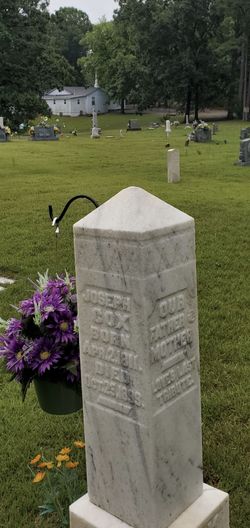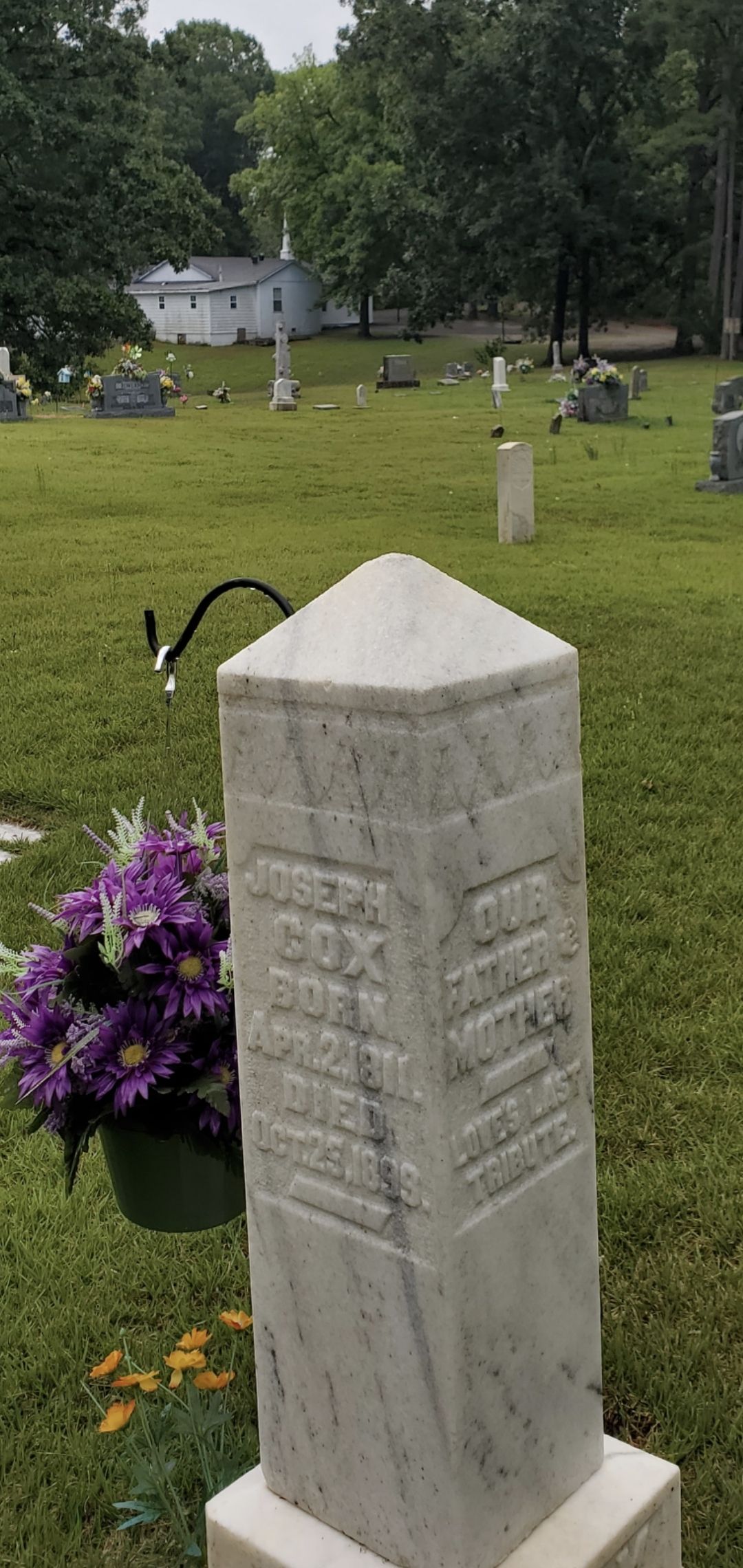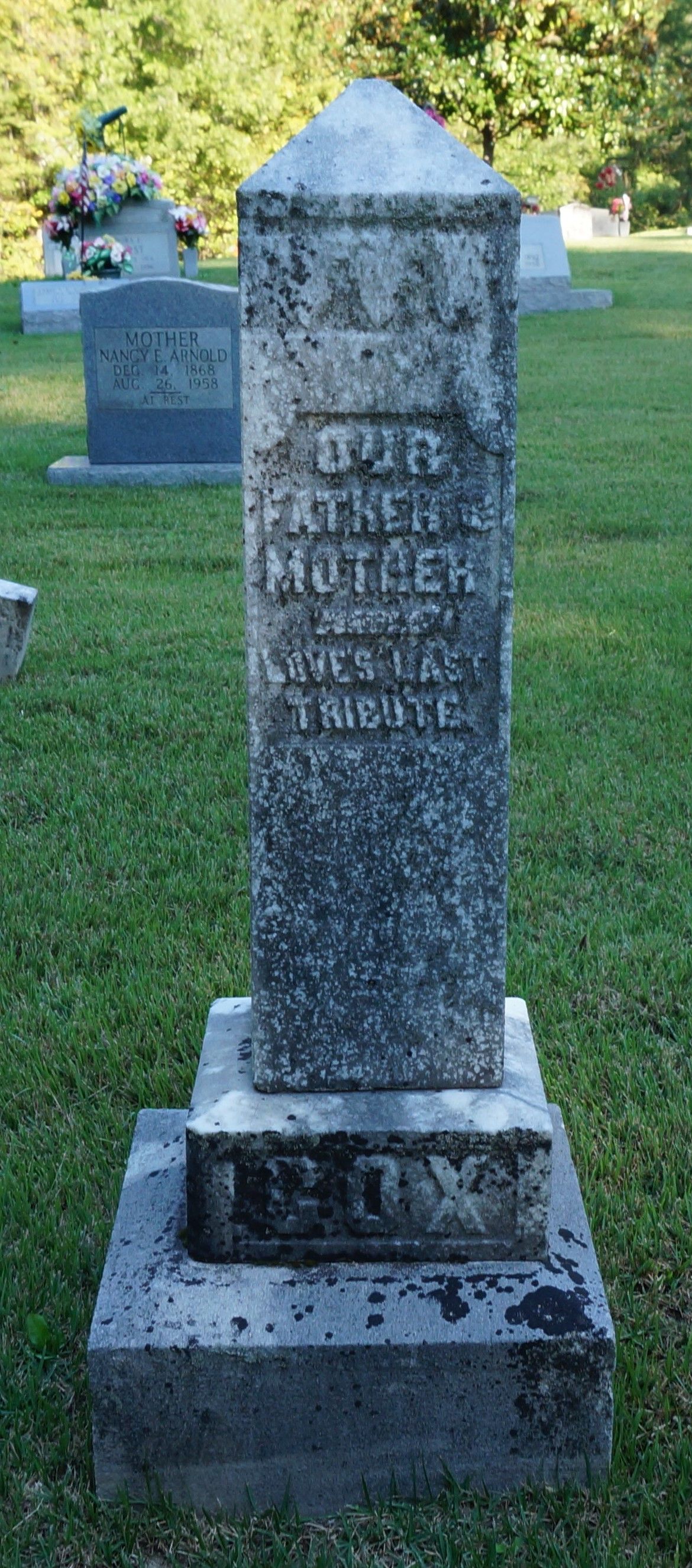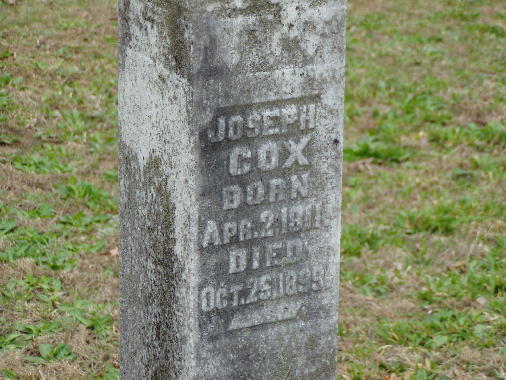Quoted from McNairy County Independent, Selmer, TN
Friday, December 17, 1948, page 6
FIRST WHITE SETTLER OF WESTERN TENN.
By Lee Jernigan
(Mr. Jernigan, former resident of McNairy County, now residing in Florida, calls upon his
memory of some 70 years to refute some historians. Mr. Jernigan is 81 and visited his friends in this
county last summer.--Editor).
There has been much discussion concerning the first white settler of Western Tennessee. The
object of this article is to settle forever the question of who was the first settler. It was Daniel Cox.
Daniel Cox was born in New Jersey in 1761. He married Dorcas Ireland Criner in 1794 and came
to Western Tennessee and settled where the town of Hornsby is now located in Eastern Hardeman
County, in April, 1811, and died at the age of 105 years.
To the Cox family belongs the honor of being the first permanent white settler of Hardeman
County and of Western Tennessee, or that part of the State between the Mississippi River and the
Tennessee River.
Writers of Tennessee History generally give that honor to John Statler, who, they say, settled
on Big Hatchie River and put in a ferry in 1819. That ferry was known as Statler's Ferry. Look at the
map of Western Tennessee in 1818, and note where the Manacie Trail crosses Big Hatchie River. This
crossing was about 3 1/2 miles South of the present town of Hornsby. The home where Mr. Statler
lived, and the ferry, were later bought by Mr. James Brint, whose descendants live near Hornsby, and
whose place is well known by the older settlers of Hornsby in 1920--many of whom knew Mr. Statler
personally in his last days.
Note this: Mr. Statler was an early settler, but not the first. Note the proof: Daniel Cox was
born in 1761. He married Dorcas Criner who had come with her father from Baltimore, Md., to New
Jersey to live in 1794, and that year she and Mr. Cox were married. Dorcas was born in 1776 and at the
time of her marriage she was 18 years old, and Mr. Cox was 33 years old.
Daniel and his wife went to Kentucky to live, but being informed that better opportunities for
hunting and fishing (for this was the occupation of Mr. Cox) and less danger of Indian ferocities, were
in North Alabama. They went to a spot near where Florence, Ala., now stands. While they lived here,
their first children were born: Alexander, who died in 1882; Wm. Joseph, who died in 1901, and Jennie,
who married Allen Fox of Gibson County, Tenn., and whose descendants are now in and around Humboldt,
Tenn.
How come Mr. Cox to go from near where Florence now stands, to Western Tennessee? It is as
follows: A party of hunters and prospectors going to what is now West Tennessee, told Mr. Cox of the
great areas of rich and level lands lying West of the Tennessee River and abounding with fish and game,
and the friendly disposition of the Cherokee Indians, urged Mr. Cox, to go with them to that section.
Hence Mr. Cox took his family and journeyed with them, crossing the Tennessee river where Savannah
stands, and following the Indian trail, they crossed the creek (now known as Wade's Creek). The party
stopped on the north side of the trail--where Hornsby Bank building now stands, to hunt and fish a few
days for wild game and fish were in abundance. The land was rich and fertile, and level. Great trees
were everywhere. They saw a few Indians who were friendly. The whole party liked the location, and
camped here several days.
1811.
Finally when they broke camp to go West, Mr. Cox refused to go with them. This was in April,
Mr. Cox brought with him a tent and a complete outfit for camping, including a few edged tools,
on a pack horse, and a huge dog, which he spoke of as his "bear dog", and a few pigs, on which he rubbed
wet gun powder every night to prevent animals from attacking them.
Mr. Cox and his family lived in this tent (where Hornsby now stands) till he could build a log
cabin in which to live. When they moved in, it was a single room affair, but later a "lean-to" was built in
which to cook and eat. Most anyone in Hornsby can point to the spot where this cabin was located.
Having become settled, Mr. Cox neglected to keep up the protection of his pigs by the use of
wet gunpowder. Hence, one afternoon he heard them in a commotion across the trail, a short distance
from the cabin. A large black bear had one down. Mr. Cox hissed his big "bear dog" and a tremendous
fight followed. Mr. Cox shot through the bear's body five times, and as he primed his flint-lock gun for
another shot, the monster had torn loose from the dog and upright with mouth wide open, he made for
Mr. Cox. It was so unexpected and so quick, and the bear was so close that Mr. Cox rammed the mussle
of the gun into the bear's mouth and shot. This killed it instantly.
How did I know all this? The grandchildren of Daniel Cox told me. These gentlemen were sons of
the children of Daniel Cox, who saw it all. The oldest of those children, Alexander, was 18 years old at
that time, and remembered every detail, and often told it to his children till his death in 1882. The rifle
was left in the family till recent years when it became lost. The prints of the bear's teeth on the gun
barrel were plain.
After Daniel Cox settled where Hornsby now stands, April 1811, in the fall of 1811 came to what
is now Lake County, Tenn, Enoch Walker, Stephen Mitchell Evan Selby, and Daniel Boone, and a few
others, and witnessed the sinking of the land that formed Reelfoot Lake on the night of Dec. 31 and
Jan. 1, 1811-12, and twenty-one years before John Stattler settled on Big Hatchie River: not in 1819 but
in 1832, as the writer has been told by John Fulghum, Billie and Haywood Howell, John N. Cox, and a
large number of others who knew Mr. Stattler intimately.
Daniel Cox died in 1866 at the age of 105 years while living with one of his children, Mrs. Mary
Fox, near the present location of Humboldt, Tenn.
The children of Daniel and Dorcas Cox were Alexander; Wm. Joseph, Jennie, who married Mr.
Fox; Mary (Polly) who married Wm. Fox and Elizabeth. Only two of these children remained in what is
now the Hornsby vicinity.
William Alexander married Bettie Fox. Their children were Edward, Abe, Eche, Alen, Ann (who
married Cate Stewart); Pollie (or Mary Jane), who married Wm. Donahoe; Elizabeth, who married Eli
Terry; Eliza, who married Jim Wright.
The children of Joseph and Sarah Rogers Cox were: Mary, who married Edward Cox; Anna, who
married Isaac Hooper; Becky Jane, who married Woods Johnson: Wm. Riley, John N., Suran [sic]
Elizabeth who married Abe Cox and after his death Nathan Hinson; Sarah, who married John Thrailkill;
Issac Franklin; Joseph; Rachel who married John Ingle; Rhoda, who married Carroll Ferguson; and
Daniel.
The descendants of all these children are yet in the Hornsby vicinity--a thrifty, keep-sighted,
well-esteemed people, and most of them are familiar with the above history--facts that should be
understood by all who enjoy Tennessee history.
Daniel Cox was the first white permanent settler of Hardeman County and of Western
Tennessee. To his descendants belongs this honor. The writer, now 81 ears old, is familiar with the
above which is only a part of the story.
Quoted from McNairy County Independent, Selmer, TN
Friday, December 17, 1948, page 6
FIRST WHITE SETTLER OF WESTERN TENN.
By Lee Jernigan
(Mr. Jernigan, former resident of McNairy County, now residing in Florida, calls upon his
memory of some 70 years to refute some historians. Mr. Jernigan is 81 and visited his friends in this
county last summer.--Editor).
There has been much discussion concerning the first white settler of Western Tennessee. The
object of this article is to settle forever the question of who was the first settler. It was Daniel Cox.
Daniel Cox was born in New Jersey in 1761. He married Dorcas Ireland Criner in 1794 and came
to Western Tennessee and settled where the town of Hornsby is now located in Eastern Hardeman
County, in April, 1811, and died at the age of 105 years.
To the Cox family belongs the honor of being the first permanent white settler of Hardeman
County and of Western Tennessee, or that part of the State between the Mississippi River and the
Tennessee River.
Writers of Tennessee History generally give that honor to John Statler, who, they say, settled
on Big Hatchie River and put in a ferry in 1819. That ferry was known as Statler's Ferry. Look at the
map of Western Tennessee in 1818, and note where the Manacie Trail crosses Big Hatchie River. This
crossing was about 3 1/2 miles South of the present town of Hornsby. The home where Mr. Statler
lived, and the ferry, were later bought by Mr. James Brint, whose descendants live near Hornsby, and
whose place is well known by the older settlers of Hornsby in 1920--many of whom knew Mr. Statler
personally in his last days.
Note this: Mr. Statler was an early settler, but not the first. Note the proof: Daniel Cox was
born in 1761. He married Dorcas Criner who had come with her father from Baltimore, Md., to New
Jersey to live in 1794, and that year she and Mr. Cox were married. Dorcas was born in 1776 and at the
time of her marriage she was 18 years old, and Mr. Cox was 33 years old.
Daniel and his wife went to Kentucky to live, but being informed that better opportunities for
hunting and fishing (for this was the occupation of Mr. Cox) and less danger of Indian ferocities, were
in North Alabama. They went to a spot near where Florence, Ala., now stands. While they lived here,
their first children were born: Alexander, who died in 1882; Wm. Joseph, who died in 1901, and Jennie,
who married Allen Fox of Gibson County, Tenn., and whose descendants are now in and around Humboldt,
Tenn.
How come Mr. Cox to go from near where Florence now stands, to Western Tennessee? It is as
follows: A party of hunters and prospectors going to what is now West Tennessee, told Mr. Cox of the
great areas of rich and level lands lying West of the Tennessee River and abounding with fish and game,
and the friendly disposition of the Cherokee Indians, urged Mr. Cox, to go with them to that section.
Hence Mr. Cox took his family and journeyed with them, crossing the Tennessee river where Savannah
stands, and following the Indian trail, they crossed the creek (now known as Wade's Creek). The party
stopped on the north side of the trail--where Hornsby Bank building now stands, to hunt and fish a few
days for wild game and fish were in abundance. The land was rich and fertile, and level. Great trees
were everywhere. They saw a few Indians who were friendly. The whole party liked the location, and
camped here several days.
1811.
Finally when they broke camp to go West, Mr. Cox refused to go with them. This was in April,
Mr. Cox brought with him a tent and a complete outfit for camping, including a few edged tools,
on a pack horse, and a huge dog, which he spoke of as his "bear dog", and a few pigs, on which he rubbed
wet gun powder every night to prevent animals from attacking them.
Mr. Cox and his family lived in this tent (where Hornsby now stands) till he could build a log
cabin in which to live. When they moved in, it was a single room affair, but later a "lean-to" was built in
which to cook and eat. Most anyone in Hornsby can point to the spot where this cabin was located.
Having become settled, Mr. Cox neglected to keep up the protection of his pigs by the use of
wet gunpowder. Hence, one afternoon he heard them in a commotion across the trail, a short distance
from the cabin. A large black bear had one down. Mr. Cox hissed his big "bear dog" and a tremendous
fight followed. Mr. Cox shot through the bear's body five times, and as he primed his flint-lock gun for
another shot, the monster had torn loose from the dog and upright with mouth wide open, he made for
Mr. Cox. It was so unexpected and so quick, and the bear was so close that Mr. Cox rammed the mussle
of the gun into the bear's mouth and shot. This killed it instantly.
How did I know all this? The grandchildren of Daniel Cox told me. These gentlemen were sons of
the children of Daniel Cox, who saw it all. The oldest of those children, Alexander, was 18 years old at
that time, and remembered every detail, and often told it to his children till his death in 1882. The rifle
was left in the family till recent years when it became lost. The prints of the bear's teeth on the gun
barrel were plain.
After Daniel Cox settled where Hornsby now stands, April 1811, in the fall of 1811 came to what
is now Lake County, Tenn, Enoch Walker, Stephen Mitchell Evan Selby, and Daniel Boone, and a few
others, and witnessed the sinking of the land that formed Reelfoot Lake on the night of Dec. 31 and
Jan. 1, 1811-12, and twenty-one years before John Stattler settled on Big Hatchie River: not in 1819 but
in 1832, as the writer has been told by John Fulghum, Billie and Haywood Howell, John N. Cox, and a
large number of others who knew Mr. Stattler intimately.
Daniel Cox died in 1866 at the age of 105 years while living with one of his children, Mrs. Mary
Fox, near the present location of Humboldt, Tenn.
The children of Daniel and Dorcas Cox were Alexander; Wm. Joseph, Jennie, who married Mr.
Fox; Mary (Polly) who married Wm. Fox and Elizabeth. Only two of these children remained in what is
now the Hornsby vicinity.
William Alexander married Bettie Fox. Their children were Edward, Abe, Eche, Alen, Ann (who
married Cate Stewart); Pollie (or Mary Jane), who married Wm. Donahoe; Elizabeth, who married Eli
Terry; Eliza, who married Jim Wright.
The children of Joseph and Sarah Rogers Cox were: Mary, who married Edward Cox; Anna, who
married Isaac Hooper; Becky Jane, who married Woods Johnson: Wm. Riley, John N., Suran [sic]
Elizabeth who married Abe Cox and after his death Nathan Hinson; Sarah, who married John Thrailkill;
Issac Franklin; Joseph; Rachel who married John Ingle; Rhoda, who married Carroll Ferguson; and
Daniel.
The descendants of all these children are yet in the Hornsby vicinity--a thrifty, keep-sighted,
well-esteemed people, and most of them are familiar with the above history--facts that should be
understood by all who enjoy Tennessee history.
Daniel Cox was the first white permanent settler of Hardeman County and of Western
Tennessee. To his descendants belongs this honor. The writer, now 81 ears old, is familiar with the
above which is only a part of the story.
Family Members
-
![]()
Mary May "Polly" Cox Cox
1838–1915
-
![]()
Hannah "Anney" Cox Hooper
1840–1875
-
![]()
Rebecca Cox Johnson
1841–1941
-
![]()
John Newton Cox
1845–1928
-
![]()
Susan E Cox Henson
1846–1890
-
![]()
Isaac Franklin Cox
1852–1932
-
![]()
William Joseph Cox
1853–1881
-
![]()
Rachel Cox Ingle
1858–1897
-
![]()
Rhoda S Cox Ferguson
1859–1897
-
![]()
Daniel Breckenridge Cox
1861–1933
Advertisement
Records on Ancestry
Advertisement


















